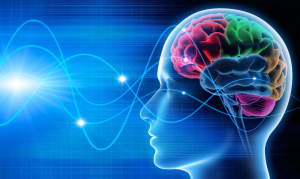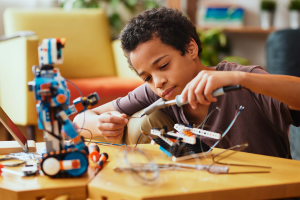Well, the short answer is YES. How cool is that?!
Our brain is capable of growth and change throughout our lives. We didn’t even know this 20 years ago. This ability is known as neuroplasticity. Knowing this has revolutionized our understanding of the brain’s potential for growth, learning, and transformation. In this article, we delve into the fascinating world of neuroplasticity, exploring what it is, how it works, and how we can harness its power to reshape our brains and lives.
The Basics
Neuroplasticity refers to the brain’s ability to reorganize itself by forming new neural connections and pathways. Contrary to the previously held belief that the brain was fixed and unchanging after a certain age, neuroplasticity highlights the brain’s incredible adaptability and potential for growth. It allows us to learn new skills, recover from injuries, adapt to changes, and reshape our thoughts, behaviors, and perceptions.
How this Happens
Neuroplasticity occurs through various mechanisms, including changes in our synapses and changes in the structures of our brain. Synaptic plasticity involves strengthening or weakening the connections between neurons, allowing for the formation of new pathways and the refinement of existing ones. Structural plasticity refers to physical changes in the brain’s structure, such as the growth of new neurons or the reorganization of neural networks.
Learning and Experience Facilitate Neuroplasticity
Our experiences and behaviors play an important role in shaping neuroplasticity. Engaging in new activities, learning new skills, and exposing ourselves to novel environments and experiences stimulates the brain’s plasticity. The more we challenge ourselves, push out of our comfort zones, and engage in active learning, the more we create opportunities for our brain to rewire and adapt.
Neuroplasticity Can Help Us Improve Ourselves
a. Engaging in cognitive exercises, such as puzzles, memory games, or learning new languages, can enhance cognitive functions and promote neuroplasticity. These activities cause us to think and problem solve, which keeps neural activity happening and growing. Puzzling over something keeps it in our working memory, the part of our brain that holds on to information while we are thinking of it. Solving a math problem in your head, remembering directions someone just told you, or thinking through potential outcomes in a social situation are good examples of working memory.
b. Getting out of our comfort zone helps us have new experiences. Experiencing the emotions that occur when we do something new and then incorporating what we learned from it changes our view of ourselves and the world. These emotions might be fear, discomfort, curiosity, excitement, or a mixture of several emotions. An experience a friend of mine recently shared will give a good example of this. The friend was traveling to Malaysia with a partner on a business trip. In planning for the trip, my friend was nervous, anticipatory, worried about managing a different currency and language, and excited about all the new sights and sounds they would experience. Overall, they were worried about making mistakes with people who were so foreign and different from themselves. Upon return, my friend reported that they learned that they could get along with people who had different values, culture, and language. She reflected that it was life changing in that she is now much more comfortable in situations with new people and has a greater sense of freedom because of it.
Trips aren’t available for everyone, but almost everyone can find small ways to explore outside of their comfort zone. Whether it is chatting with someone at the store, driving to a new area, trying a new recipe, starting a new hobby, or having a deeper conversation with someone, these or similar activities can help us grow new skills and experiences.
c. Participating in physical exercise has been shown to enhance neuroplasticity by promoting the growth of new neurons and the formation of neural connections. Many researchers have identified the connection between exercise and our brain’s production of Human Growth Hormone (hGH), and they even call it “Miracle Grow for the Brain.”
d. Practicing mental training, such as mindfulness, attention training, or meditation techniques increases neuroplasticity and brain change. Mental training is proven to enhance attention and concentration, working memory, long term memory, and efficient cognitive processing. Structural changes actually occur with meditative practices and can be seen using neuroimaging techniques like MRI, MEG and EEG. In addition to these brain and thinking improvements, mental training is good for our physical health. Decades of research show that mental training reduces stress, improves our immune functioning, reduces inflammation in our bodies and fosters emotional well-being. All of these outcomes improve our ability to learn and create new neural pathways.
e. Challenging negative thoughts and behaviors helps us reshape neural pathways associated with unhelpful patterns and grow more positive and adaptive ones. Similar to the benefits of mindful meditation, when we challenge negative thought patterns our brain is more relaxed and optimistic. We have more room and mental energy for positive thoughts and noticing the good things in life. When we are angry, stressed, or frustrated our bodies are programmed to use our calories and nutrition resources to face the challenge. In contrast, when we are calm and relaxed our body can use those resources to repair and grow. Irritating things still happen, but we are more able to respond to them effectively because we aren’t already in a stressed state. We can think of this as being in the “red zone” or the “green zone.” When we are full of anger, stress, worry or reactivity we are in the red zone. The “green zone” is calm, nourished, and comfortable. The green zone creates a rich environment for growth, creativity, and possibility.
When we change negative or unhealthy behaviors, we have more time, energy and resources for healthy choices. We can replace habits that harm or limit us with activities and surroundings that increase our happiness and wellbeing. It can be difficult to transition from watching television or your favorite videos after dinner to moving your body, but within a few days you’ll probably notice more energy and optimism.
Neuroplasticity Helps Us Recover
Neuroplasticity plays a crucial role in rehabilitation and recovery from brain injuries, strokes, and neurological conditions. Physical therapy, speech therapy, and cognitive rehabilitation all utilize neuroplasticity to help individuals regain lost functioning and rewire the brain to compensate for or heal the damage.
Final Words
When you hear “people don’t change” don’t believe it! By understanding and harnessing the power of neuroplasticity, we can actively reshape our brains, improve cognitive abilities, overcome challenges, and promote personal growth and well-being. Embracing new experiences, engaging in active learning, and adopting positive habits can facilitate neuroplasticity, empowering us to unlock our brain’s remarkable potential and lead fulfilling, adaptive lives.
You can heal and grow, but it does take effort and consistency. We’ll help you learn and understand what you can do to strengthen your neuroplasticity for best results. So, let’s embrace the potential available to us and embark on a journey of lifelong learning, growth, and transformation. Your brain might just be your best friend.





